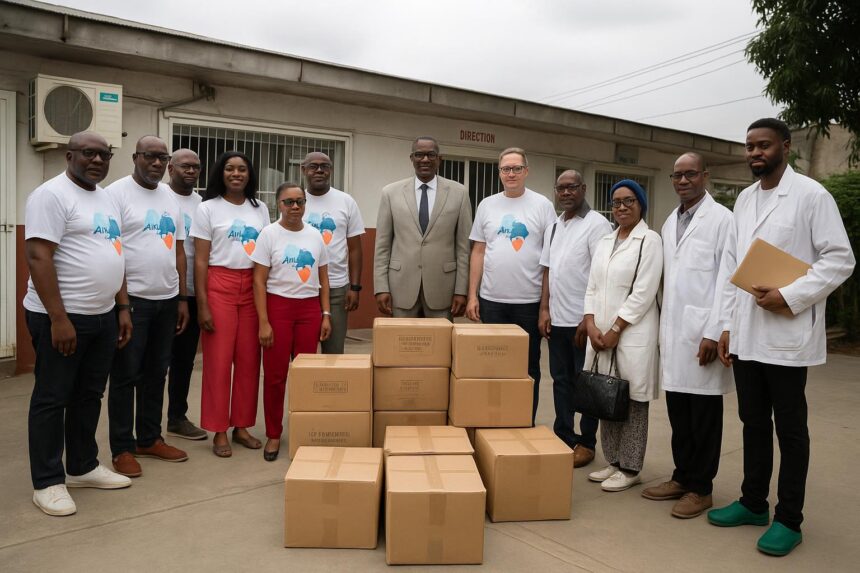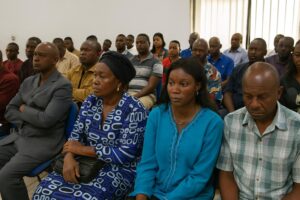AGL delivers 2,500 double bags to CNTS
Forklifts rolled into the Brazzaville compound of the National Blood Transfusion Centre on 19 September 2025, unloading 2,500 sterile double blood-collection bags donated by Africa Global Logistics and its Congolese branches AGL Congo, Congo Terminal and Terminaux du Bassin du Congo.
- AGL delivers 2,500 double bags to CNTS
- Why blood storage matters in Congo
- A’Solidarity Day, more than a slogan
- Record mobilisation of volunteers
- Looking back at last year’s classroom boost
- Partners praise a win-win model
- Healthy workforce, stronger logistics
- Community voices welcome fresh hope
- What happens next
- Blood donation made easier on mobile phones
Medical staff applaud the gesture; according to director Dr Juste Ngoma, the stock will cover roughly two months of urban demand and, crucially, allow mobile teams to reach remote districts where emergency blood shortages still claim preventable lives.
Why blood storage matters in Congo
Congo’s hospitals collect barely a third of the 80,000 units the WHO recommends annually for the population, health authorities concede; sterile bags are essential because each improper collection risks discarding a precious donation.
Infections, maternal haemorrhage and road trauma inflate the need, especially in Pointe-Noire’s busy corridors. AGL’s gift, valued by pharmacists at over 30 million CFA francs, eases procurement costs for the Ministry of Health, which recently urged private partners to bolster medical supplies.
A’Solidarity Day, more than a slogan
A’Solidarity Day, the corporate volunteer programme driving the donation, unites 23,000 employees across Africa each September around a concrete action theme. This year, blood safety took centre stage after internal surveys flagged healthcare as the top concern voiced by staff families.
“Solidarity is part of our logistics chain,” explains AGL Congo CEO Franck Diop. “Moving goods is meaningless if communities around our ports lack the blood that moves life.” Workers in branded T-shirts echoed the message during a morning jog along the Congo Riverfront.
Record mobilisation of volunteers
“In both Brazzaville and Pointe-Noire we aim to rally 1,500 colleagues to roll up their sleeves,” human-resources manager Nicole Moukoula tells us, pointing to sign-up sheets that filled within hours. The civil-service union welcomed the initiative, promising to synchronise public‐sector drives.
Past company campaigns show that each volunteer convinces at least one external donor, so organisers hope for a ripple effect that could secure 4,000 extra units before year-end, a scenario officials say would push national coverage above 45 percent for the first time.
Looking back at last year’s classroom boost
Last September, the same A’Solidarity Day built a protective wall around Pointe-Noire’s 5 February 1979 primary school, whose 3,500 pupils previously studied metres from fast traffic. Teachers credit that work, plus a fresh coat of paint on every classroom, for a calmer learning environment.
Parent delegate Clarisse Boukinda recalls, “Before the fence we rescued balls from the road daily; since then not one child has crossed the highway unsupervised.” Her story became AGL’s favourite slide during this year’s kickoff, illustrating how targeted infrastructure can save lives.
Partners praise a win-win model
Health authorities praise the private-public partnership model. “The State sets priorities; companies like AGL bring efficiency and speed,” notes Ministry of Health adviser Paul Ibara, citing shorter procurement paperwork for donated goods compared with international grants that can take semesters.
AGL’s port operations also benefit, executives admit. Faster customs clearance for humanitarian cargo generates goodwill among regulators, while a healthier labour pool reduces absenteeism. The cycle, they argue, feeds productivity without straining the national budget, making corporate solidarity a strategic asset.
Healthy workforce, stronger logistics
Sustainability consultants see another upside: aligning blood-donation outreach with core logistics skills lets AGL showcase cold-chain expertise, from temperature-controlled vans to inventory software, in real-world conditions that later serve paying clients in the pharmaceutical sector.
Investors monitoring environmental, social and governance indicators highlighted the initiative during the company’s latest board call. Analysts at Brazzaville brokerage CGF Bourse forecast that strong ESG scores could reduce borrowing costs as regional banks integrate social metrics into credit decisions.
Community voices welcome fresh hope
Outside the finance circles, residents simply feel reassured. “It’s heart-warming to know a port operator thinks about blood banks, not just containers,” says bakery owner Alain Mayanda, who lost a cousin to postpartum bleeding last year. He plans to donate next week.
Student nurse Mireille Okouélé, meanwhile, packs the new bags into cupboards. She believes the gesture will inspire confidence among youth donors often wary of old equipment. “If you see fresh, sealed kits, you feel safe,” she smiles before rushing to the paediatric ward.
What happens next
CNTS plans to dispatch the first batches to Talangaï hospital within days; AGL teams will monitor delivery, sharing live tracking data online. Organisers hint that next year’s solidarity theme could target school nutrition, underscoring an ambition to keep expanding the blood-of-life metaphor.
Blood donation made easier on mobile phones
During the handover ceremony, AGL’s IT unit unveiled a prototype app that lets citizens locate the nearest authorised blood-draw point and book a slot. The Ministry confirmed plans to integrate the platform with its e-health portal once pilot tests finish in October.
Developers say anonymised usage statistics could help planners predict peaks, sending mobile teams where demand surges—an optimisation principle already familiar to a logistics giant. For now, young Congolese welcome the idea of donating ‘like ordering a taxi,’ as one tweet joked.
AGL pledged to cover the first year’s server costs, an amount executives describe as ‘less than moving a single container but potentially life-changing for thousands’.






















